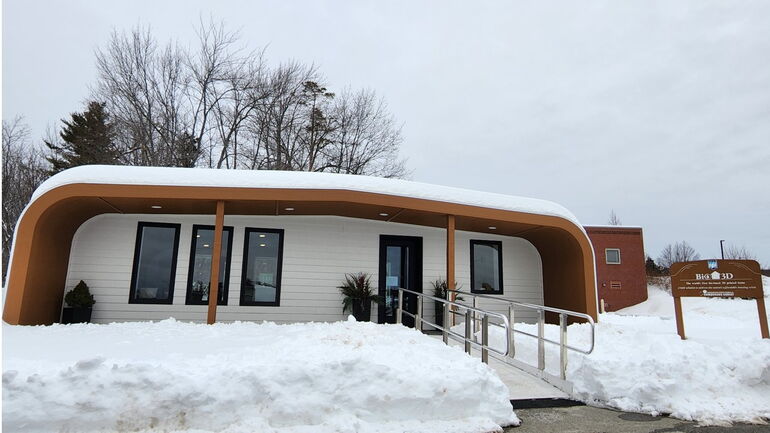
University of Maine sees success with 3D-printed, sustainable house
 University of Maine
The University of Maine's sustainable, 3D-printed prototype house
University of Maine
The University of Maine's sustainable, 3D-printed prototype house
The University of Maine attracted global attention last year within the sustainable design community when its engineers unveiled a house entirely manufactured by a 3D printer whose ink was made of wood residue.
Now, after a year of leaving it outside and using sensors and observations to measure every inch of the place, the project team confirms the 600-square-foot house is livable — a seemingly basic requirement but a significant milestone toward scaling up production of affordable, sustainable dwellings in Maine.
Affordability and sustainability are two concepts that don’t always necessarily go hand-in-hand within the construction sector. Plastic and concrete, for instance, are low-cost building materials, but they’re linked to devastating environmental consequences for the climate and environment. And sustainably built dwellings that get the most spotlight are often luxury-priced properties.
But the university’s prototype flips that script by creating homes that are both cheap and predominantly made with biobased, or formerly living, materials, according to Habib Dagher, founding director of the University of Maine Advanced Structures and Composites Center.

To do so, engineers loaded up a massive 3D printer with a byproduct abundantly available but typically wasted in Maine: wood residuals.
By mostly utilizing this byproduct instead of typical building materials — some concrete was used for the prototype’s foundational posts but likely won’t be needed in the future — the team took advantage of the roughly 1 million tons of the material created annually in Maine.
Plus, the team says using wasted wood products means its house sequesters around 46 tons of carbon emissions, equivalent to the carbon-trapping ability of around 50 acres of forest, according to the U.S. Environmental Protection Agency. Dagher noted the process itself only results in between 20% to 30% of the emissions of a typically constructed home.
“Each 600-square-foot unit requires approximately 10 tons of wood residuals, meaning 100,000 units could theoretically be produced every year using the sawmill residuals,” according to a UMaine press release. “Not all residuals will be used for this purpose, but this provides a sense of the available feedstock resource.”
Field testing
The engineering team began outdoor testing of the 3D-printed prototype in late November 2022, with the plan to gather data and evaluate their project’s ability to withstand the elements over the course of the year. The engineers didn’t have to wait long to test the mettle of their home.
A heavy windstorm just after Thanksgiving served as “the very first major event where we saw Mother Nature, if you wish, unloading on the structure,” said Dagher. Although the team worried there might be cracks or deformity from so much wind, that fear never became reality.
Not long after the storm, Dagher recalls one night when the wind chill factor dropped significantly below zero, another significant hurdle for the experimental house to overcome. He was giving a tour of the property at the time.
“We had to run from our lab to the building because it was so cold outside, and then we got in there and it felt nice and warm, exactly the temperatures that were set and very cozy,” he said.
Mainebiz web partners
Will the floor plan be customizable ?












1 Comments